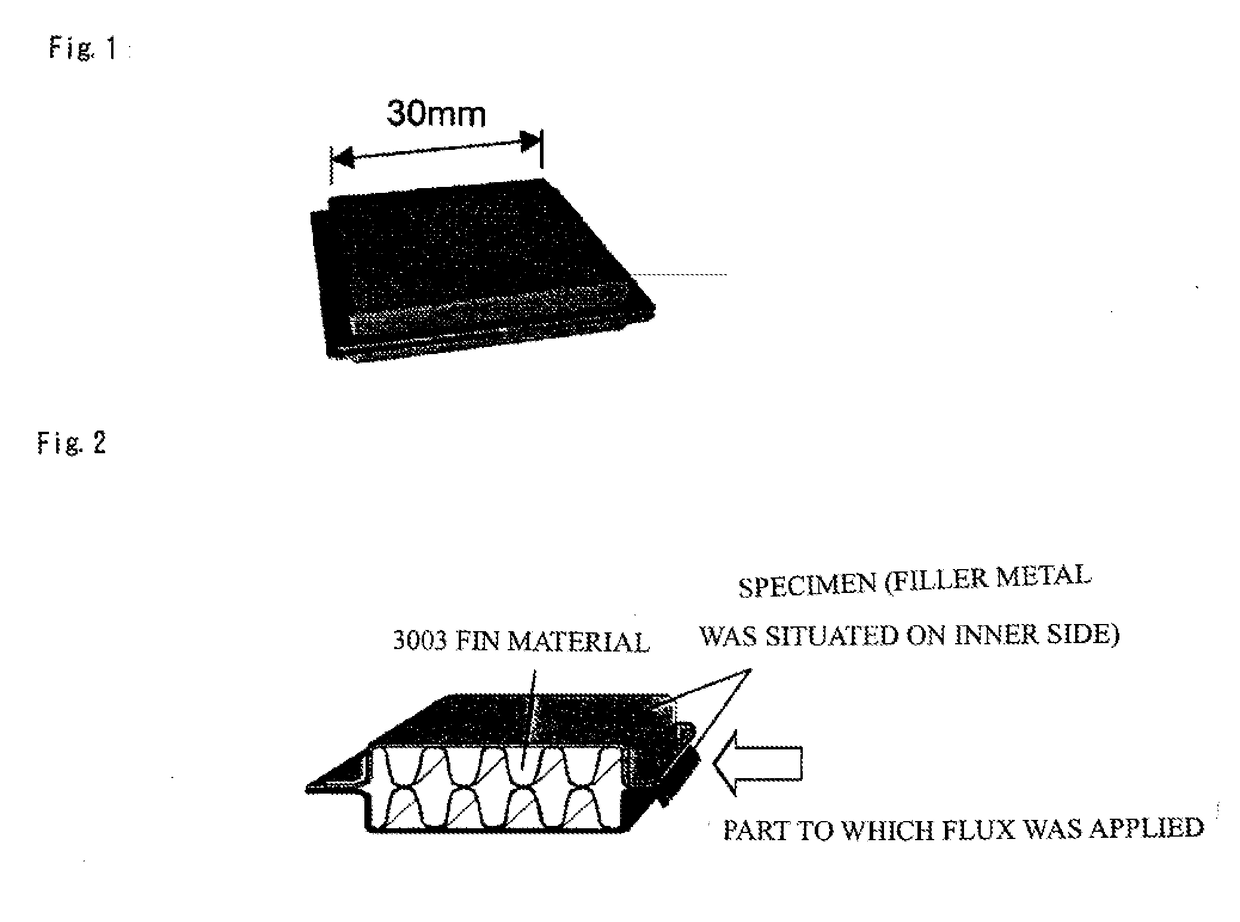Aluminum alloy brazing sheet and brazing method
a technology of alloy brazing sheet and brazing method, which is applied in the direction of soldering apparatus, manufacturing tools, light and heating equipment, etc., can solve the problems of increasing equipment cost and maintenance cost, difficult uniform bonding between core material and filler metal, and increasing equipment cost and maintenance costs. , to achieve the effect of low oxide formation free energy, high heating temperature during brazing, and high efficiency
- Summary
- Abstract
- Description
- Claims
- Application Information
AI Technical Summary
Benefits of technology
Problems solved by technology
Method used
Image
Examples
example 1
[0051]Aluminum alloys (i.e., an aluminum alloy for producing a filler metal, an aluminum alloy for producing a core material, an aluminum alloy for producing a sheet material, and an aluminum alloy for producing a sacrificial anode material) respectively having the composition listed in Table 1 were subjected to continuous casting to obtain ingots. The ingot for producing a core material was ground to have a length of 163 mm, a width of 163 mm, and a thickness of 27 mm. The ingot for producing a filler metal was hot-rolled to have a thickness of 3 mm, and cut to have a length of 163 mm and a width of 163 mm.
[0052]The ingot for producing a sheet material was hot-rolled to have a thickness of 3 mm, cold-rolled to have a thickness of 0.25 to 2 mm, and cut to have a length of 163 mm and a width of 163 mm. The ingot that was merely cut was also used as the sheet material. The ingot for producing a sacrificial anode material was hot-rolled to have a thickness of 3 mm, cold-rolled to have ...
example 2
[0063]Aluminum alloys (i.e., an aluminum alloy for producing a filler metal, an aluminum alloy for producing a core material an aluminum alloy for producing a sheet material, and an aluminum alloy for producing a sacrificial anode material) respectively having the composition listed in Table 3 were subjected to continuous casting to obtain ingots. A soft clad sheet material (specimen) having a thickness of 0.4 mm was produced in the same manner as in Example 1. The specimen was pressed in the shape of a cup, degreased using acetone (“Unetched” in Table 3), or degreased using acetone, and etched using a weak acid (“Etched” in Table 3), and a fin obtained by forming and degreasing a 3003 alloy sheet material having a thickness of 0.1 mm was provided inside the specimen to prepare a cup specimen illustrated in FIG. 1. A flux (fluoride flux basically including KF and AlF3) that was diluted with an alcohol was applied to the outer side of the flare joint of the cup specimen (indicated by...
PUM
| Property | Measurement | Unit |
|---|---|---|
| Percent by mass | aaaaa | aaaaa |
| Percent by mass | aaaaa | aaaaa |
| Percent by mass | aaaaa | aaaaa |
Abstract
Description
Claims
Application Information
 Login to View More
Login to View More - R&D
- Intellectual Property
- Life Sciences
- Materials
- Tech Scout
- Unparalleled Data Quality
- Higher Quality Content
- 60% Fewer Hallucinations
Browse by: Latest US Patents, China's latest patents, Technical Efficacy Thesaurus, Application Domain, Technology Topic, Popular Technical Reports.
© 2025 PatSnap. All rights reserved.Legal|Privacy policy|Modern Slavery Act Transparency Statement|Sitemap|About US| Contact US: help@patsnap.com



